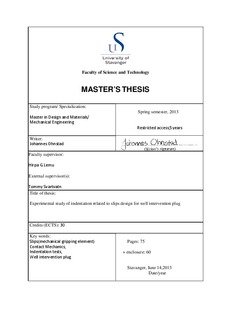| dc.contributor.author | Ohnstad, Johannes | |
| dc.date.accessioned | 2014-02-06T09:09:16Z | |
| dc.date.issued | 2013-06 | |
| dc.identifier.uri | http://hdl.handle.net/11250/183194 | |
| dc.description | Master's thesis in Structural engineering | no_NO |
| dc.description.abstract | On behalf of the well technology E plug, an experimental study has been conducted on the subject of indentation related to a mechanical component called slips. Slips are a type of metal wedge element with sharpened teeth profiles designed for the purpose of anchoring plugs and other types of downhole equipment in an oil well. Anchoring is achieved by sharpened teeth profiles on the surface of the slips indenting the wall of the production tubing, which in turn causes a radial gripping force that provides resistance to plug movement. E plug has experienced some technical difficulties in determining the ideal geometry for the teeth profiles on their slips, which is used on their well intervention plug, the TorcPlug®.
The goal of the thesis has been to find a correlation between applied load, indentation pressure, surface area, indenter angle and depth of penetration. This, in turn could prove beneficial in design of teeth profiles for the TorcPlug®. Based on the theory studied on the subject of indentation, seven indenters were tested during a series of indentation tests. The indenters had different geometries which purpose was to resemble the teeth profiles on the slips. The indentation tests were performed at E Plug’s workshop.
A hypothesis related to indentation pressure, indenter hardness and depth of penetration for each of the indenters was developed before testing. The hypothesis for all except one of the indenters was based on a theory called the slip line field theory. The indenters were made of the steel grade AISI 4140, heat treated to a hardness value of 50-51HRc. The steel which indentations were made on was chosen in order to resemble the mechanical properties of production tubing and was also of the steel grade AISI 4140. However a grade with different mechanical properties and a hardness value of around 18-22HRc. Indentation tests were performed with a hydraulic press. The plastic impression left on the indented steel was measured by the use of a microscope at UiS, measured results were then compared and analyzed together with load data.
The test results showed that the slip line field theory did not accurately predict the indentation pressure or the depth of penetration for 60˚ and 120˚ angled wedge shaped indenters. The deviation between theoretical and measured values is likely due to the assumption of plane strain (2-dimensionality) not being fulfilled which is an important assumption in slip line field theory. However, a large collection of measured data in relation to geometric properties of the indentations at a wide range of loading has been produced. Regression curve analysis has been performed on the measured data and an iterative equation based on the curves that produces approximately correct values has been suggested.
A successful method of calculating indentation pressure, depth of penetration and plastic surface area at a given load has been discovered for a pyramid shaped indenter with a 90° face angle. The theoretical calculations matched the test results by a margin of less than one percent on the lowest load to three percent on the highest load. A mathematical model for calculating the indentation pressure for axi-symmetric pyramid shaped indenters of different angles has been presented. The model is called the expanding cavity model. The indentation pressure calculated by using the model is supported by physical data from the indentation tests.
The two most effective indenters in terms of depth of penetration in relation to the applied load were the pyramid and 60˚ wedge indenters. At loads up to around 1100kg the pyramid is the most effective in terms of penetration. Between 1100-1450kg there is a transition area where the 60˚ wedge indenter becomes more effective than the pyramid.
Unfortunately the indenters that were tested for the purpose of demonstrating the relation between surface area and indentation pressure failed as a result of excessive deformation during testing. The deformation of these indenters can be accounted to an incomplete heat treatment which led to a lower total hardness value. Two of the other indenters that were tested experienced minor deformation at the first stage of testing. The deformation of these two indenters gradually worsened as the applied load was increased during the later stages of testing.
For future design considerations the teeth profiles chosen for slips application should have a hardness value of at least two and a half times that of the indented metal (tubing). Preferably the hardness ratio should be even higher if possible. The profiles should have the same volume in order to achieve equal hardness from heat treatment procedures.
A proposed design for a slip element has been produced. Teeth profiles chosen are similar to the pyramid indenter which during the course of the study has been found to be the most suited indenter profile for slips application. | no_NO |
| dc.description.sponsorship | E Plug | no_NO |
| dc.language.iso | eng | no_NO |
| dc.publisher | University of Stavanger, Norway | no_NO |
| dc.relation.ispartofseries | Masteroppgave/UIS-TN-IKM/2013; | |
| dc.subject | slips (mechanical gripping element) | no_NO |
| dc.subject | contact mechanics | no_NO |
| dc.subject | indentation tests | no_NO |
| dc.subject | well intervention plug | no_NO |
| dc.subject | materialteknologi | no_NO |
| dc.subject | byggkonstruksjoner | no_NO |
| dc.title | Experimental study of indentation related to slips design for well intervention plug | no_NO |
| dc.type | Master thesis | no_NO |
| dc.subject.nsi | VDP::Technology: 500::Mechanical engineering: 570 | no_NO |
| dc.description.embargo | 2018-06-14 | |
| dc.source.pagenumber | 136 | no_NO |
